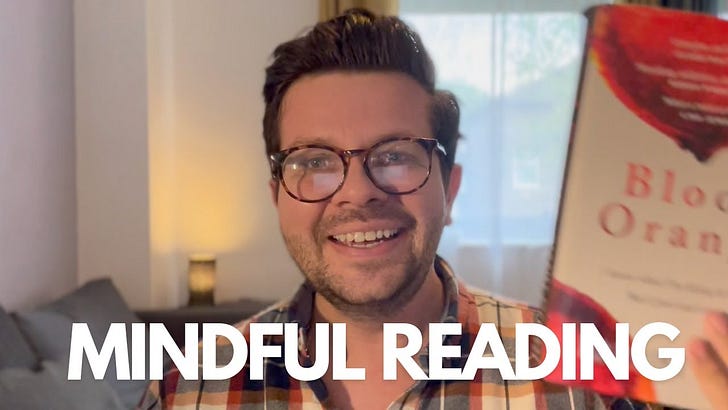There’s a really special kind of magic that occurs when we allow ourselves—truly allow ourselves—to sit down and be with a book.
Not trying to conquer it.
Not trying to mine it for insights, citations, or cleverness.
But simply allowing the book to change us.
And it doesn’t have to be one of the Greats. It might be a novel pulled from an airport shelf, a dog-eared bit of non-fiction, or something wildly popular on social media. What matters, really, is the relationship—that mysterious, interior bond—between reader and text. When we stop reading to consume and start reading to connect, we enter an entirely different realm. One of presence, transformation, and quiet joy.
In this piece, I want to offer five mindful practices that have radically shifted my relationship with reading. These are the tools I’ve used—sometimes deliberately, sometimes by accident—to turn hundreds of books into portals. Into moments of encounter. Into invitations toward deeper awareness.
1. Breathe before you read
This one might sound obvious. But try it.
Before you crack the spine, before your eyes scan the opening line, just pause. Take three deep breaths. Feel your body. Let the air anchor you.
In that small space of stillness, something shifts. You move from a state of doing to a state of receiving. You attune your awareness, as Parker Palmer so beautifully describes, to “the hidden wholeness” within.
Reading, when approached this way, becomes a kind of ritual. A liturgy of stillness. An act of gentle, deliberate care.
2. Let the book read you
This is the real turning point.
When we stop trying to master a book and instead let it become a mirror—something astonishing happens. We start noticing ourselves. Our reactions. Our resistance. Our longing.
So as you read, ask:
What part of me is responding to this?
What part of me is shrinking away?
Who am I becoming as I turn these pages?
This is how reading becomes a practice of self-inquiry. A slow unveiling. Not just of the author’s ideas, but of the interior life we too often rush past.
3. Listen to the marginal whisper
I still prefer physical books. The kind that get dog-eared, underlined, scribbled on. But whether you’re reading a paperback or a Kindle, try letting yourself mark the moment. A thought. A symbol. A half-formed reaction.
This isn’t about academic annotation. This is about dialogue.
A little star beside a phrase that moved you. A sad face by a passage that stung. A few scratched words wondering why this section made you feel so seen—or so alone.
These notes aren’t distractions. They’re fingerprints. Proof that you were here, in this exact emotional landscape, at this exact time in your life. When you return—months or years later—those scribbles won’t just tell you what the book said. They’ll tell you who you were when you first met it.
4. Savour a single sentence
Yes, the to-be-read pile is huge. Yes, there’s never enough time.
But just once during your reading session—pause. Choose a sentence that lands in your gut. And read it again. And again. Read it out loud. Let it echo through your nervous system.
Where does it settle? Does it soften something? Tighten something? Spark a flicker of joy or grief or recognition?
To savour is to stop the clock. To step outside the rush and allow the sentence not just to be understood—but to be embodied.
5. End with silence
This is the most overlooked practice, but perhaps the most potent.
When you finish a chapter—or even a few pages—don’t immediately scroll, switch tasks, or fall asleep. Just sit. Let the words linger. Let them hang in the air like incense.
That silence is not empty. It’s the ground in which meaning germinates.
This is the moment where the integration begins. The moment where reading stops being passive and becomes transformative.
Because in the end, we don’t read simply to finish another book or accumulate more knowledge. We read to become more alive to language. To imagination. To ourselves.
We read to practice presence.
We read to remember that even in this fractured, frantic world, there are still portals. Still spellbooks. Still sacred encounters waiting patiently on our shelves, asking only that we bring our whole selves to the page.
If this resonates, and you're curious about how these ideas intersect with meditation, creative practice, and everyday consciousness, I invite you to explore my online course on integrative meditation. It’s a contemplative toolkit for thinkers, makers, and those who sense there’s something more.
📚✨
Let me know in the comments: what book last changed you—and how did you know it had?



